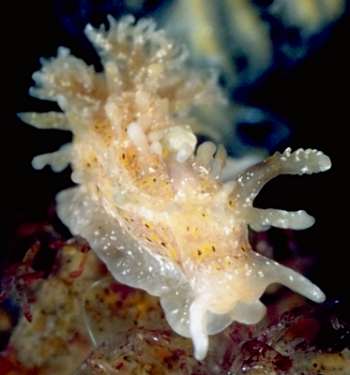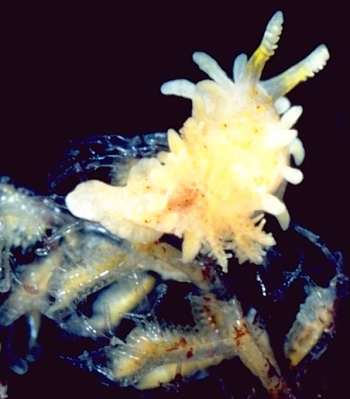

Okenia mija
Burn, 1967
Order: NUDIBRANCHIA
Suborder: DORIDINA
Superfamily: ANADORIDOIDEA
Family: Goniodorididae
DISTRIBUTION
South-eastern Australia (Tasmania, Victoria, New South Wales).
PHOTO
Blackmans Bay, Derwent River, Hobart, Tasmania, subtidal on ctenostome bryozoan Amathia wilsoni, [see lower photo] 18 November 1986, [many hundreds seen] approx. 12mm long, AM C151776. Photos: Bill Rudman
The animal is small, elongate with a distinct mantle edge bearing a series of about 7 lateral papillae which are spindle shaped when fully extended, being slightly wider in the mid-region than at the base, and tapering to a rounded tip. However the shape is somewhat variable within an individual and in stressed animals the papillae can be cylindrical in shape, often with a slightly swollen tip. In some animals there is an irregular row of up to 6 papillae on each side of the body, and there are also many dorsal papillae of varying size. The rhinophores are about twice the length of the lateral papillae and have up to 6 characteristic cup shape structures on the upper half two-thirds, each having a notch in the posterior mid-line.
The body is translucent clear with a faint brownish tinge from the underlying visceral mass and a fine dusting of brown over the skin. There are also small opaque white patches scattered over the body and particularly in a band around the mantle edge creating a whitish border in some specimens. The white patches also form an irregular line down the dorsal midline. On the dorsum and sides of the body there are scattered yellowish brown irregular shaped patches, each with a dark brownish black spot, which is often but not always, in the centre of the patch. The lateral papillae appear white, especially at the tip, from a concentration of these white patches, and the rhinophores are translucent clear except for white patches on the cup-shaped lamellae. The gills are transparent except for scattered white and brown patches. A description of the radula is posted separately [message #12638 ].
Okenia mija seems to be one of a number of small brownish species of Okenia found in south-eastern Australia, but unfortunately apart for this species and Okenia zoobotryon, too few specimens of the other species or 'forms' are available to determine their status. Externally Okenia mija can be distinguished by the mantle ridge which runs all around the body, the. The relatively short and dorsoventrally flattened lateral papillae, the arrangement of the dorsal papillae and the distinctive shape of the rhinophore lamellae. Two distinctive features of the colour pattern are a translucent clear band around the mantle edge with many opaque white specks, and large light brown patches each with a central dark brown spot which are scattered over the dorsum and the sides of the body.
I have found it feeding on the ctenostome bryozoan Amathia wilsoni. Kirkpatrick 1888 in Tasmania.
-
Burn, R. (1967). Descriptions of two new species of Okenia (Nudibranchia, Doridacea) from south-eastern Australia. Proceedings of the Royal Society of New South Wales 1965-66: 52-57.
-
Rudman, W.B. (2004) Further species of the opisthobranch genus Okenia (Nudibranchia: Goniodorididae) from the Indo-West Pacific. Zootaxa, 695: 1-70.
ARCHIVE NOTE: An earlier edition of this Fact Sheet [17 Feb 1999] is available on request.
Authorship detailsRudman, W.B., 2004 (December 21) Okenia mija Burn, 1967. [In] Sea Slug Forum. Australian Museum, Sydney. Available from http://www.seaslugforum.net/factsheet/okenmija
Related messages
-
Okenia mija from Port Stephens, NSW
From: Leanne and David Atkinson, November 20, 2009 -
Okenia mija from Bare Island, Sydney
From: Nicholas Missenden, September 17, 2005 -
Radula of Okenia mija
From: Bill Rudman, December 21, 2004 -
Re: Okenia mija
From: Ross Armstrong, February 18, 1999 -
Okenia mija - new record for New Zealand?
From: Ross Armstrong, February 17, 1999
